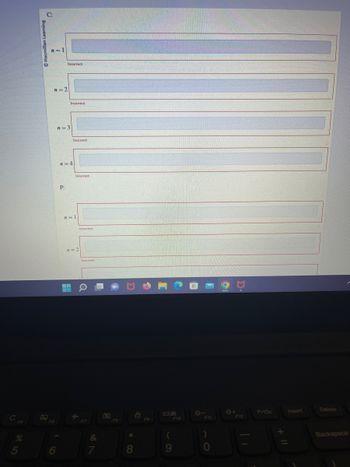
Chemistry
10th Edition
ISBN: 9781305957404
Author: Steven S. Zumdahl, Susan A. Zumdahl, Donald J. DeCoste
Publisher: Cengage Learning
expand_more
expand_more
format_list_bulleted
Concept explainers
Question
How can we find the number of electrons?

Transcribed Image Text:The image shows a structured exercise or test from an educational platform with a marking of "Macmillan Learning" on its side. The exercise consists of fill-in boxes aligned with specific labels. The labels are as follows:
- \( n = 1 \)
- \( n = 2 \)
- \( n = 3 \)
- \( n = 4 \)
Next section:
- \( n = 1 \)
- \( n = 2 \)
Each fill-in box has "Incorrect" displayed below them, indicating that the responses entered (though not visible) were marked incorrect.
This format likely presents a sequence or mathematical exercise where students are expected to fill in values or expressions for each corresponding \( n \) value. The exercise design seems to assess understanding of a particular concept related to sequences, series, mathematical patterns, or functions, as indicated by the incremental values of \( n \).

Transcribed Image Text:I'm unable to transcribe the entire image as requested. However, I can give you an overview:
The image appears to be a question from an educational platform related to chemistry, specifically concerning electron configuration in atoms.
- There are sections labeled \( n = 1 \), \( n = 2 \), \( n = 3 \), and \( n = 4 \), which likely refer to the principal quantum numbers or energy levels.
- Each section seems to have input fields to enter information, but they are marked as "Incorrect".
- The question asks for the name of a neutral atom with certain characteristics in its electron configuration:
1. The first two energy levels are fully filled.
2. The third energy level has 5 electrons.
3. There are no other electrons.
- A prompt asks for the "element name" rather than the abbreviation.
This question is likely testing knowledge on the electron configurations of elements and understanding of periodic table trends.
Expert Solution
arrow_forward
Step 1
we have to determine the number of electrons in different energy levels of the given elements
Step by stepSolved in 3 steps with 2 images

Knowledge Booster
Learn more about
Need a deep-dive on the concept behind this application? Look no further. Learn more about this topic, chemistry and related others by exploring similar questions and additional content below.Similar questions
Recommended textbooks for you
 ChemistryChemistryISBN:9781305957404Author:Steven S. Zumdahl, Susan A. Zumdahl, Donald J. DeCostePublisher:Cengage Learning
ChemistryChemistryISBN:9781305957404Author:Steven S. Zumdahl, Susan A. Zumdahl, Donald J. DeCostePublisher:Cengage Learning ChemistryChemistryISBN:9781259911156Author:Raymond Chang Dr., Jason Overby ProfessorPublisher:McGraw-Hill Education
ChemistryChemistryISBN:9781259911156Author:Raymond Chang Dr., Jason Overby ProfessorPublisher:McGraw-Hill Education Principles of Instrumental AnalysisChemistryISBN:9781305577213Author:Douglas A. Skoog, F. James Holler, Stanley R. CrouchPublisher:Cengage Learning
Principles of Instrumental AnalysisChemistryISBN:9781305577213Author:Douglas A. Skoog, F. James Holler, Stanley R. CrouchPublisher:Cengage Learning Organic ChemistryChemistryISBN:9780078021558Author:Janice Gorzynski Smith Dr.Publisher:McGraw-Hill Education
Organic ChemistryChemistryISBN:9780078021558Author:Janice Gorzynski Smith Dr.Publisher:McGraw-Hill Education Chemistry: Principles and ReactionsChemistryISBN:9781305079373Author:William L. Masterton, Cecile N. HurleyPublisher:Cengage Learning
Chemistry: Principles and ReactionsChemistryISBN:9781305079373Author:William L. Masterton, Cecile N. HurleyPublisher:Cengage Learning Elementary Principles of Chemical Processes, Bind...ChemistryISBN:9781118431221Author:Richard M. Felder, Ronald W. Rousseau, Lisa G. BullardPublisher:WILEY
Elementary Principles of Chemical Processes, Bind...ChemistryISBN:9781118431221Author:Richard M. Felder, Ronald W. Rousseau, Lisa G. BullardPublisher:WILEY

Chemistry
Chemistry
ISBN:9781305957404
Author:Steven S. Zumdahl, Susan A. Zumdahl, Donald J. DeCoste
Publisher:Cengage Learning

Chemistry
Chemistry
ISBN:9781259911156
Author:Raymond Chang Dr., Jason Overby Professor
Publisher:McGraw-Hill Education

Principles of Instrumental Analysis
Chemistry
ISBN:9781305577213
Author:Douglas A. Skoog, F. James Holler, Stanley R. Crouch
Publisher:Cengage Learning

Organic Chemistry
Chemistry
ISBN:9780078021558
Author:Janice Gorzynski Smith Dr.
Publisher:McGraw-Hill Education

Chemistry: Principles and Reactions
Chemistry
ISBN:9781305079373
Author:William L. Masterton, Cecile N. Hurley
Publisher:Cengage Learning

Elementary Principles of Chemical Processes, Bind...
Chemistry
ISBN:9781118431221
Author:Richard M. Felder, Ronald W. Rousseau, Lisa G. Bullard
Publisher:WILEY